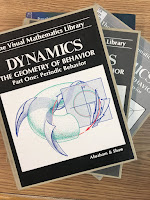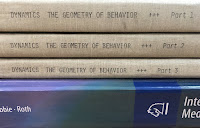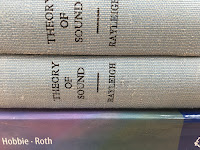As December draws to a close and I reflect on all that’s happened over the last twelve months, I conclude that 2012 has been a good year. For me, it has also marked some important anniversaries. Thirty years ago (1982) I graduated from the
University of Kansas with a bachelors degree in
physics. Twenty-five years ago (1987) I obtained my PhD from
Vanderbilt University. And twenty years ago (1992) I was at the
National Institutes of Health in Bethesda, Maryland working on
magnetic stimulation of nerves.
Today I want to focus on one particular paper published in 1992 that examined magnetic stimulation of a
peripheral nerve: “
Determining the Site of Stimulation During Magnetic Stimulation of a Peripheral Nerve” (
Electroencephalography and Clinical Neurophysiology, Volume 85, Pages 253–264). To understand this article, we must first examine
Frank Rattay’s analysis of electrical stimulation. Rattay showed that excitation along a nerve
axon occurs where the “
activating function” –
λ2 d2Ve/dx2 is largest, with
λ the
length constant,
Ve the extracellular potential produced by a stimulating electrode, and
x the distance along the axon. Homework Problem 38 in Chapter 7 of the 4th edition of
Intermediate Physics for Medicine and Biology guides you through Rattay’s derivation. In 1990,
Peter Basser and I
showed that this result also holds during magnetic stimulation. What is
magnetic stimulation? In Chapter 8 of
Intermediate Physics for Medicine and Biology,
Russ Hobbie and I discuss
Faraday’s law of induction, and then write
Since a changing magnetic field generates an induced electric field, it is possible to stimulate a nerve or muscle cells with out using electrodes…One of the earliest investigations was reported by Barker et al. (1985) who used a solenoid in which the magnetic field changed by 2 T in 110 μs to apply a stimulus to different points on a subject’s arm and skull.
The main difference between Rattay’s analysis of electrical stimulation and our analysis of magnetic stimulation was that Rattay expressed his activation function in terms of the electric potential produced by the stimulus electrode, whereas Basser and I considered the induced electric field along the axon,
Ex, and wrote the activating function as
λ2 dEx/dx. The most interesting feature of this result is that stimulation does not occur where the electric field is strongest, but instead where its gradient along the axon is greatest. In the early 1990s, this result was surprising (in retrospect, it seems obvious), so we set out to test it experimentally.
Basser and I both worked in NIH’s
Biomedical Engineering and Instrumentation Program, and we had neither the expertise nor facilities to perform the needed experiments, but we knew who did. Since arriving at NIH in 1988, I had been working with
Mark Hallett and
Leo Cohen to develop clinical applications of magnetic stimulation. Also collaborating with Hallett was a delightful couple visiting from Italy,
Jan Nilsson and his wife
Marcela Panizza. Under Hallett’s overall leadership, with Nilsson and Panizza making the measurements, and with me occasionally making suggestions and cheerleading, we carried out the key experiments that confirmed Basser’s and my prediction about where excitation occurs. These studies were performed on human volunteers (at that time there were people who made their living as paid normal volunteers in clinical studies at NIH) and were carried out in the
NIH clinical center.
The abstract of our now 20-year old paper said
Magnetic stimulation has not been routinely used for studies of peripheral nerve conduction primarily because of uncertainty about the location of the stimulation site. We performed several experiments to locate the site of nerve stimulation. Uniform latency shifts, similar to those that can be obtained during electrical stimulation, were observed when a magnetic coil was moved along the median nerve in the region of the elbow, thereby ensuring that the properties of the nerve and surrounding volume conductor were uniform. By evoking muscle responses both electrically and magnetically and matching their latencies, amplitudes and shapes, the site of stimulation was determined to be 3.0 ± 0.5 cm from the center of an 8-shaped coil toward the coil handle. When the polarity of the current was reversed by rotating the coil, the latency of the evoked response shifted by 0.65 ± 0.05 msec, which implies that the site of stimulation was displaced 4.1 ± 0.5 cm. Additional evidence of cathode- and anode-like behavior during magnetic stimulation comes from observations of preferential activation of motor responses over H-reflexes with stimulation of a distal site, and of preferential activation of H-reflexes over motor responses with stimulation of a proximal site. Analogous behavior is observed with electrical stimulation. These experiments were motivated by, and are qualitatively consistent with, a mathematical model of magnetic stimulation of an axon.
Rather than describe this experiment in detail, I will let you analyze it yourself in a new homework problem (your three-days-late Christmas present). It is similar to a problem from an exam I gave to my biological physics (PHY 325) students.
Section 8.7
Problem 26 ½ (a) Rederive the cable equation for the transmembrane potential v (Eq. 6.55) using one crucial modification: generalize Eq. 6.48 to account for part of the intracellular electric field that arises from Faraday induction and therefore cannot be written as the gradient of a potential,
Assume you measure v relative to the resting potential so Eq. 6.53 becomes jm = gm v, and let the extracellular potential be small so vi = v. Identify the new source term in the cable equation (the “activating function” for magnetic stimulation), analogous to vr in Eq. 6.55.
(b) Let
Calculate the activating function and plot both the electric field and the activating function versus x.
(c) Suppose you stimulate a nerve using this activating function, first with one polarity of the current pulse and then the other. What additional delay in the response of the nerve (as measured by the arrival time of the action potential at the far end) will changing polarity cause because of the extra distance the action potential must travel? Assume a = 4 cm and the conduction speed is 60 m/s.
At about the same time as we were doing this study,
Paul Maccabee and his colleagues at the
SUNY Health Science Center in Brooklyn were carrying out similar experiments using an
in-vitro pig nerve model (a nerve in a dish), and came to similar conclusions (“
Magnetic Coil Stimulation of Straight and Bent Amphibian and Mammalian Peripheral Nerve In Vitro: Locus of Excitation,”
Journal of Physiology, Volume 460, Pages 201–219, 1993). Our paper was published first (Yes!!!) but their results were cleaner and more elegant, in part because they didn’t have the complication of the nerve being surrounded by irregularly shaped muscles and bones. Our paper has been fairly influential (53 citations to date in the
Web of Science), but theirs has had an even greater impact (147 citations). A year later Maccabee and I together published a
study of a new magnetic stimulation coil design.
What has happened to this cast of characters in the last 20 years? Hallett and Cohen remain at NIH, still doing great work. Nilsson is a biomedical engineer and Panizza is a neurophysiologist in Italy. Basser is at NIH, but is now with the
Eunice Kennedy Shriver National Institute of Child Health and Human Development, where he works on
MRI diffusion tensor imaging. Paul Maccabee is a neurologist and the Director of the EMG Laboratory at SUNY Brooklyn. I left NIH in 1995, and am now at
Oakland University, where I teach, do research, and write a
blog so I can wish readers of
Intermediate Physics for Medicine and Biology a Happy New Year!







